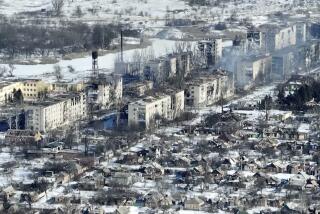Soviets Turn Over Afghan Minefield Maps : Military: Millions of land mines planted during civil war need to be cleared. Relief officials fear that refugees will not return until problem is solved.
- Share via
KABUL, Afghanistan — Preparing to close the book on a decade of military involvement in Afghanistan, the Soviet Union has turned over the last maps that pinpoint where its troops planted millions of land mines.
Relief officials working to help clear the mines say they fear that unexploded mines will be the biggest deterrent to the return of nearly 6 million refugees who have fled the fighting in this nation’s civil war.
With no agreement yet on ending the war, the combatants are still laying mines, and experts say it will be years before all can be cleared.
Moscow has promised to cut off arms shipments to President Najibullah’s government and to withdraw its military advisers by the end of the year. That will end military help that began with the April, 1978, revolution that put the Communists in power in Kabul.
The Kremlin sent about 115,000 soldiers into Afghanistan the next year to prop up the government against Muslim insurgents. During their nine-year occupation, Soviet soldiers laid millions of mines in the fight against the U.S.-backed rebels--known as moujahedeen , or Islamic holy warriors.
Mines frequently kill and maim innocent Afghans, most of them young children who mistake the mines for toys. Kabul hospital officials say four to five children are admitted almost daily with mine injuries.
No one knows exactly how many mines were planted, but Western diplomats in Pakistan say the number could be as high as 30 million.
Col. Abdul Shakour, who heads the Afghan government’s national commission for mine clearance, said that number was highly exaggerated.
“From the documents we have, we estimate there are between 2 million and 2.5 million mines. But we have no documents from the moujahedeen , and this will be a problem for them and for us,” Shakour said in an interview.
The moujahedeen groups, which spend almost as much time fighting each other as the Kabul government, have transplanted Soviet mines to use against rivals. Relief officials say the moujahedeen have not kept records of their minefields.
When Moscow withdrew the last Soviet troops in February, 1989, it left some minefield maps behind. Shakour said the remainder were delivered to the government recently.
But even with the maps, it may be a monumental task to find the mines. Many have been moved by snow, wind and rain in this rugged, mountainous country.
“We may lose many people trying to clear them from those areas, even with the maps,” he said.
Shakour estimates that the job will take six to 10 years.
“If there is sufficient modern equipment, sufficient financial assistance and manpower, it would not take so long. But without, it will be an impossible job,” he said.
More to Read
Sign up for Essential California
The most important California stories and recommendations in your inbox every morning.
You may occasionally receive promotional content from the Los Angeles Times.










